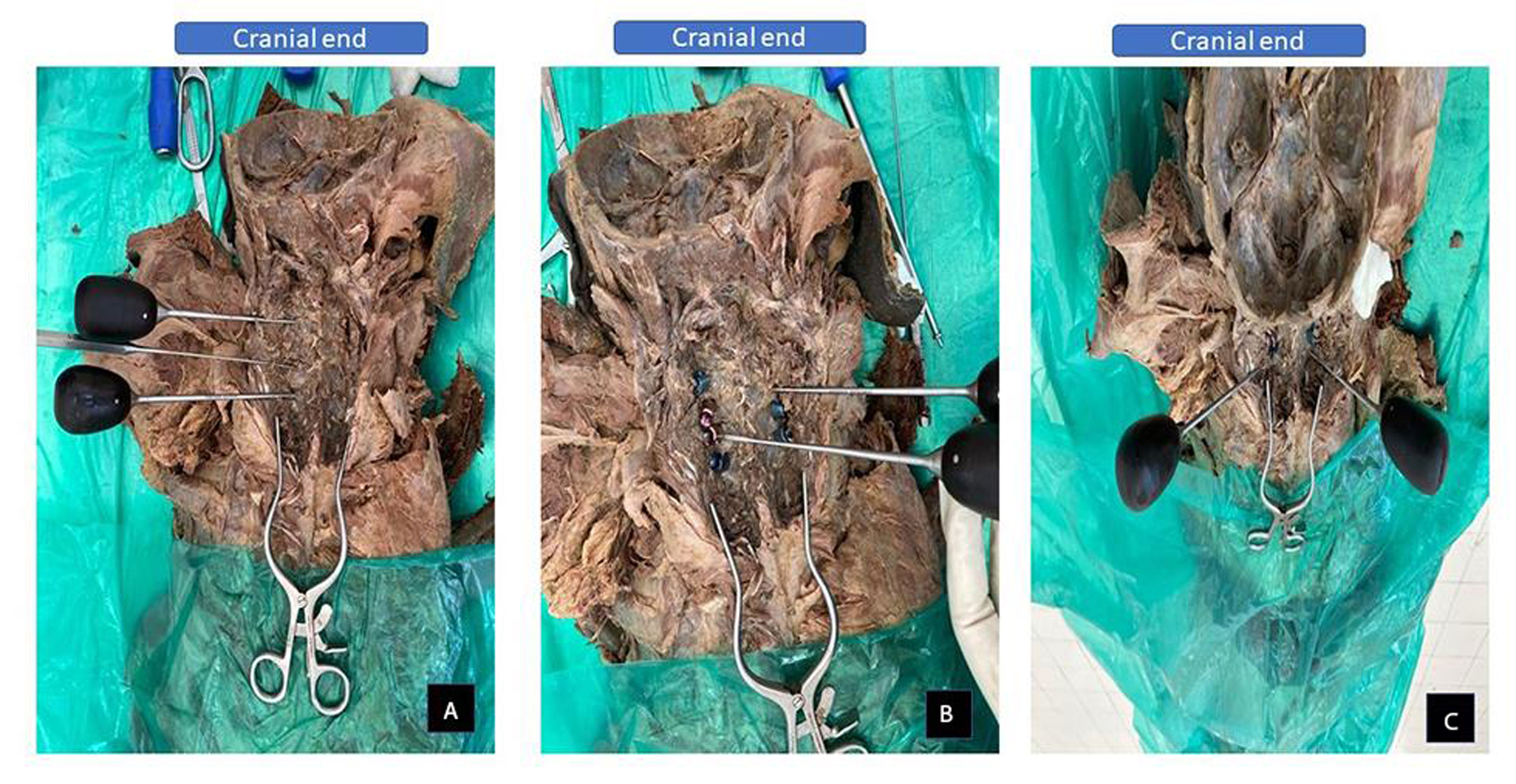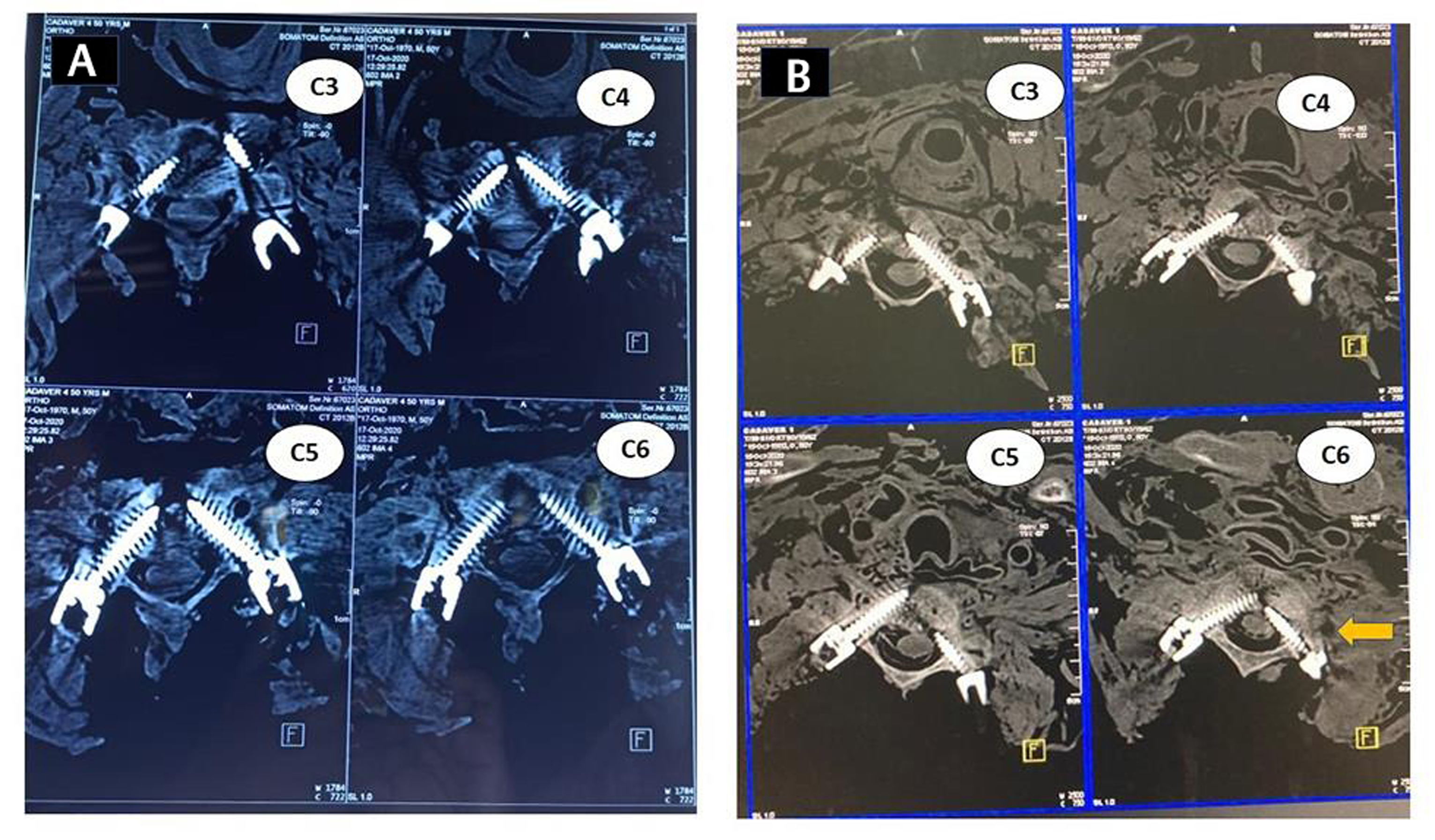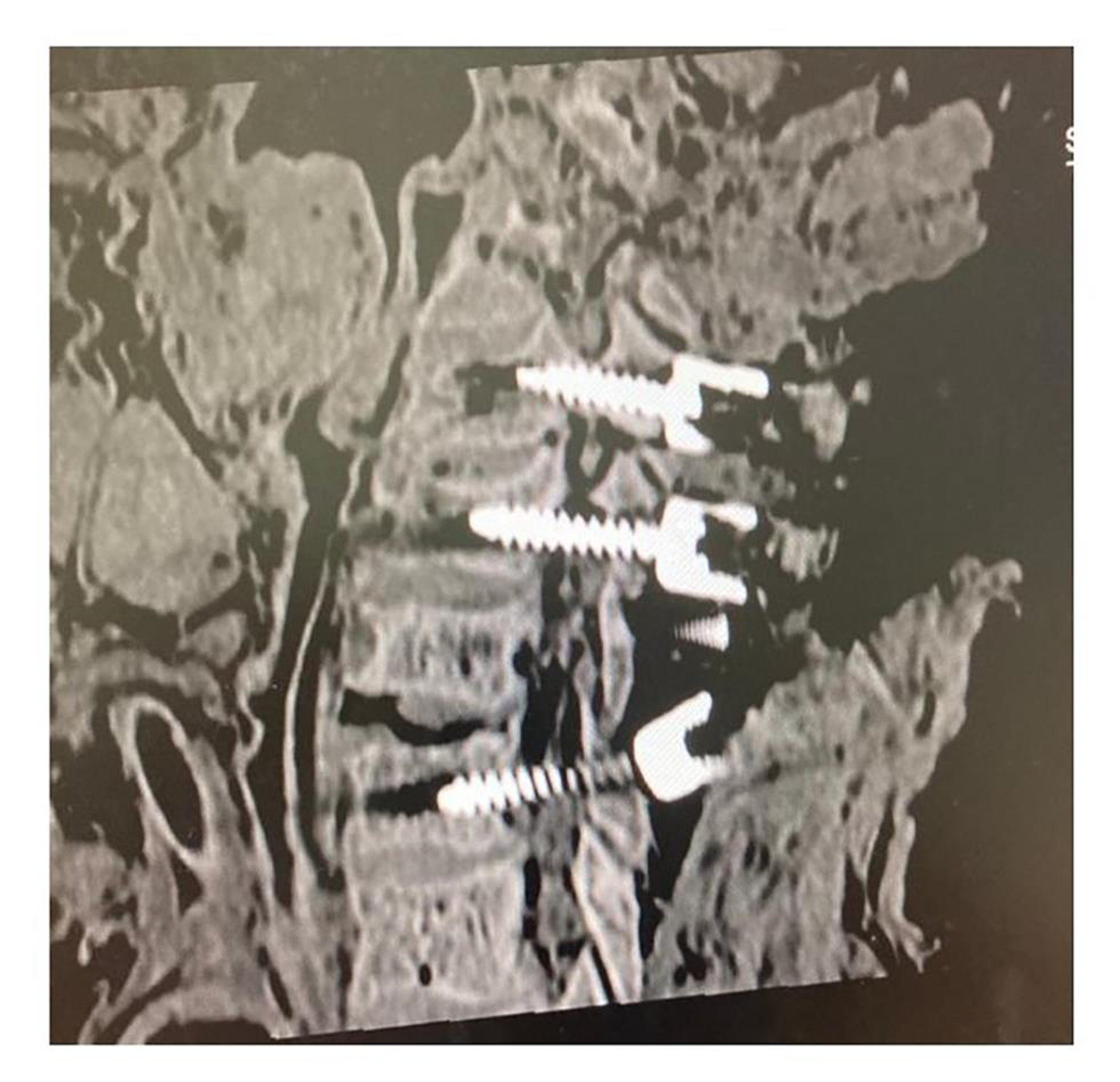Translate this page into:
Validation of Freehand Cervical Pedicle Screw Placement in Subaxial Spine Using the “Burcev Technique”: A Cadaveric Study
Mantu Jain, 106, Mahadev Orchid Cosmopolis Road Dumduma, Bhubaneswar 751019, Odisha India montu_jn@yahoo.com
This article was originally published by Thieme Medical and Scientific Publishers Pvt. Ltd. and was migrated to Scientific Scholar after the change of Publisher.
Abstract
Abstract
The present study attempted to validate the “Burcev freehand method” based on anatomical observations in Indian cadavers. The study was conducted on 32 cervical pedicle screws (CPSs) that were placed in four cadavers by the authors according to the “freehand technique,” described by Burcev et al, without the aid of fluoroscopy and the trajectory verified by computed tomography scans. The screws were designated as satisfactory, permissible, or unacceptable. Descriptive variables were represented in number and percentages, continuous variables were represented as mean ± standard deviation (SD). Of the 32 CPSs placed, 24 (75%) exhibited a satisfactory position, 1 (3%) exhibited a permissible position, and 7 (22%) exhibited an unacceptable position. Of the seven CPSs in the unacceptable group, four exhibited a lateral breach and three exhibited a medial breach, whereas the CPS in the permissible group exhibited a medial breach. The overall angle with contralateral lamina in the horizontal plane in terms of mean ± SD was 175.43 ± 2.82, 169.49, and 169.65 ± 6.46 degrees in the satisfactory, permissible, and unacceptable groups, respectively. In the sagittal plane, the screws exhibited an angle of 88.15 ± 3.56 degrees. No breach was observed superiorly or inferiorly. The “Burcev technique” is replicable with similar results in cadavers. Further studies must be conducted in a clinical setting to ensure its safety.
Keywords
cervical pedicle screw
freehand technique
Burcev’s method
cadaver
Introduction
Pedicle screws have been the cornerstone in spine instrumentation, particularly in the lumbar and thoracic spine.1 2 3 The cervical spine is complicated in anatomy because of its close relationship with the cervical spinal cord medially and the vertebral artery laterally. Thus, the placement of the screw without causing injury to the neurovascular structures is challenging because a wrong placement could be catastrophic for patients.4 5 In the cervical spine, C2 and C7 pedicle screws have been universally accepted to be “safe” and routinely used freehand technique.6 7 However, screw insertion in the subaxial spine, namely, C3–6, is still challenging for surgeons and the optimal approach remains unknown. In 1994, Abumi et al first described a technique of freehand cervical pedicle screw (CPS) placement, and the technique has been subsequently modified.4
In 2017, Burcev et al described a “freehand” technique, which they described as an “easy and fast method” for safe CPS placement.8 Although the anatomical observation of the authors was appealing and straightforward, none of the authors have reiterated their findings. The present study aims to validate the “freehand technique,” described by the authors, in Indian cadavers.
Materials and Methods
The present study was conducted in four-stored cadavers after obtaining institutional ethics clearance. A waiver of consent was obtained to use the formalin-preserved cadavers in the anatomy department of the institute (T/IM-MF/Ortho/19/62 dated December 16, 2019). The cadavers were placed prone on the dissecting table, and the dissection was performed deep to the bones. One assistant (S.P.) steadied the cadaver, and one spine surgeon (M.J.) performed the procedure described by Burcev et al by using a “freehand technique.”8 Only the subaxial spine C3–6 was instrumented, omitting the C7, which is now an established technique. The entry point for the CPSs was 2-mm medial and inferior to the facet joint between the involved and rostral vertebrae at a trajectory parallel (180 degrees) to the contralateral lamina and at an angle of 90 degrees to the sagittal plane ( Fig. 1 ). No fluoroscopic assistance was used in the process. Four screws (3.5 mm × 24–26 mm, Jayon India Limited) were placed on each side in each cadaver. The cadavers were then transferred to the radiology department in a waterproof covering for computed tomography (CT) scans. A 64-slice CT scanner (GE Lghtspeed 64 slice CT scanner) was used to take images at a thickness of 3 mm. The axial images were then used to evaluate the screw positions. The assessment was also categorized on the same scale described by Burcev et al (Table 1 ).8

-
Fig.1 Images showing the screw insertion in progress. The angle in the horizontal plane is seen one side in (A), and both sides in (C). (B) The parallelism with contralateral lamina done.
Fig.1 Images showing the screw insertion in progress. The angle in the horizontal plane is seen one side in (A), and both sides in (C). (B) The parallelism with contralateral lamina done.
|
x completely in a pedicle with no breech on either side |
Spinal canal (medial breach) |
Vertebral foramen (lateral breach) |
|
|---|---|---|---|
|
Abbreviation: CPS, cervical pedicle screw. |
|||
|
CPS placement |
Satisfactory (75%) |
Permissible (3.1%) Medial: 1 |
Unacceptable (22%) Lateral: 4 Medial: 3 |
|
Laminar screw angle |
173.98 ± 4.53 (160.77–179.52) |
Medial: 173.98 ± 4.53 Lateral: 165.84 ± 4.05 |
|
|
Sagittal angle |
88.15 ± 3.56 |
||
Data were entered in the excel sheet, and SPSS version 21 (Microsoft, Chicago, Illinois, United States) was used for data analysis. The angle made by the screw with the contralateral lamina was calculated using the Surgimap tool online. Sagittal images were taken to detect a superior or inferior breech.
Results
During the cadaveric study, 32 CPSs were inserted in C3–6 pedicles (Figs. 2 and 3). Of these inserted CPSs, 24 (75%) exhibited a satisfactory position, 1 (3%) exhibited a permissible position, and 7 (22%) exhibited an unacceptable position. In the unacceptable group, four screws exhibited a lateral breach and three screws exhibited a medial breach, whereas the only CPS in the permissible group exhibited a medial breach ( Figs. 2 and 3, arrow marked). The angle with contralateral lamina measured in mean ± standard deviation (SD) was 173.98 ± 4.53 degrees, with a minimum of 160.77 degrees and a maximum of 179.52 degrees. Angle in the satisfactory, permissible, and unacceptable groups was 175.43 ± 2.82, 169.49, and 169.65 ± 6.46 degrees, respectively. The mean ± SD for the medial breach was 173.98 ± 4.53 degrees, whereas that for the lateral breach was 165.84 ± 4.05degrees.

-
Fig. 2 Axial CT scan pictures of subaxial spine of two cadavers (A, B). The sole medical breach that is permissible is depicted with an arrow. CT, computed tomography.
Fig. 2 Axial CT scan pictures of subaxial spine of two cadavers (A, B). The sole medical breach that is permissible is depicted with an arrow. CT, computed tomography.

-
Fig. 3 Axial CT scan pictures of subaxial spine of next two cadavers (A, B). The medial breaches are depicted in red arrows and lateral breach in yellow arrows. CT, computed tomography.
Fig. 3 Axial CT scan pictures of subaxial spine of next two cadavers (A, B). The medial breaches are depicted in red arrows and lateral breach in yellow arrows. CT, computed tomography.
In the sagittal plane, the screws made an angle of 88.15 ± 3.56 degrees. No superior or inferior breach was observed ( Fig. 4 ).

-
Fig. 4 Sagittal CT scan image of a cadaver showing the screws in position. CT, computed tomography.
Fig. 4 Sagittal CT scan image of a cadaver showing the screws in position. CT, computed tomography.
Discussion
Pedicle screw placement offers three-column stability in the thoracic or lumbar spine and is the most rigid posterior fixation method.9 However, use of CPS is limited because of the low margin of error that increases the risk of damage to the spinal cord medially, vertebral vessels laterally, and to the exiting nerve that lies in close proximity to the pedicle. Several anatomical and clinical studies have been performed on CPS fixation, with each study having unique trajectories, tricks, and tips to avoid pedicle breach.4 8 9 10 11 12 13 14 15 16 17 18 However, these “freehand techniques” have not gained widespread popularity among spine surgeons. The last two decades have been an era of digital navigation, and robotic technology has improved the CPS placement technique.19 20
Although navigation offers surgical safety to patients without complications, it requires a sophisticated set up with expensive armamentarium.21 Sometimes, cervical spine alignment can change intraoperatively that leads to inaccurate placement due to the C-spine.17 These shortcomings limit the application of the “digital navigation technology” in a few centers. Thus, the search for a universally accepted method for the safe placement of CPS continues.
In 1994, Abumi et al first described the early results of 13 patients treated with transpedicular fixation of the cervical spine.4 The authors suggested that the entry point must be just lateral to the center of the facet and close to the posterior margin of the superior articular surface. While a burr was used initially to enlarge the entrance hole, the screw was angled from 25 to 45 degrees medially in the horizontal plane, parallel to the upper endplate of the vertebral body in the sagittal plane. The authors used a small nerve retractor to probe the path with the help of an image intensifier. Although neurological improvement was observed in some patients, deterioration though CT could not properly delineate the exact direction.
Jeanneret et al performed a cadaveric study in the same year and placed 33 screws of which 10 had a minor breach of the pedicle. They used a point 3 mm below the facet joint on the midpoint of the lateral mass. The drill was angled medially, averaging 45 degrees aiming toward the cranial third of the vertebral body. The authors performed this method successfully on three patients.13
Miller et al in 1996 conducted a comparative study of blind technique versus partial laminectomy and tapping method in eight cadavers. They reported a decreased incidence and severity of pedicle violation in the partial laminectomy group as compared with the blind group. They did not recommended the routine use of this method owing to the risk involved in pedicle screw placement.11
In 1996, Ebraheim et al conducted a cadaveric study and observed that the foramen transversarium is in the same sagittal plane as the midpoint of the lateral mass.6 Therefore, they recommended starting from the superiolateral corner of the lateral mass; the trajectory should be 10-degree cephalad (C6–7), 10-degree caudal (C3–4), vertical for C5 in the sagittal plane, 40- 47-degree medially (C3–6), and slightly less for C7.
In 2009, Xu et al used Ebraheim’s technique to place 114 screws in 36 patients (mostly including patients with cervical trauma). They reported an overall 88.9% satisfactory position with no neurovascular complications. Other studies have also been conducted with some variability in the entry point and trajectory.10
Lee et al in 2012 described a key slot technique for CPS placement. These investigators inserted 277 in 50 patients. A right-angled triangle on the axial plane was created in the medial half of the lateral mass with a 3-mm burr. The apex of trainagle was at the inlet of pedicle. The authors had a 90% acceptability without any catastrophic neurovascular complication in their cases.17
Wang et al in 2013 described a freehand technique of CPS insertion which they assessed using a CT scan. These researchers used a small curette to palpate the thick medial pedicle wall and pass a drill in appropriate trajectory by repeated palpation. The lateral breech of pedicle was found to be 12.64% of which 9.86% was grade I and 2.63% was grade II.18
Lee et al in 2017 described a “medial funnel technique” that included visualization of pedicle using laminoforaminotomy and simultaneous probing, the authors used 88 CPS in 28 patients with 94.3% correct placement. There was no neurovascular complication in their series.12
Wu et al in 2017 also described an entry point for CPS placement based on coronal multiplane reconstruction image.22 The authors referred this as the “lateral vertebral notch technique” where the entry point was found to be consistently 2.2-mm medial and 1.4 mm below the lateral vertebral notch for C3–6 vertebrae. The authors subsequently extrapolated the described technique in human cadaver and found 96.7% acceptability in 120 CPS.23
In 2020, Liu et al described a “sliding technique,” wherein they inserted 251 screws in patients with cervical trauma. They exhibited a high (90%) intrapediclar placement with no neurovascular complication. The authors recommended their technique as safe and effective for the placement of pedicle screw in the subaxial spine.9
Our findings for CPS placement are concurrent with those described by the original authors.8 The “Acceptable” (combined “satisfactory” and “Permissible”) percentage of the CPS is same as described by them. We strictly adhered to the author’s method and did not apply the modifications such as “burring deep” described by Abumi et al, use of a smaller probe, sliding method, or a small laminotomy for tactile perception reported by other authors that could have improved the results.4 9 10 14 We observed that screws having a medial breach had an entry point more medially (>2 mm inside the outer margin of lateral mass), whereas those having a lateral breach had a more lateral entry point ( Fig. 5 ). Intraoperative fluoroscopy can be used to choose the entry point in clinical settings.

-
Fig. 5 The error of entry points that lead to (A) medial breach (red arrow) and (B) lateral breach (yellow arrow) are depicted.
Fig. 5 The error of entry points that lead to (A) medial breach (red arrow) and (B) lateral breach (yellow arrow) are depicted.
Limitations of the Study
The present study is a cadaveric study that lacks clinical validation. However, the results mirror those of the authors’ cadaveric portion of the study and, hence, the method is reproducible.
The formalin-preserved bones are softer than the actual dried vertebrae or vertebrae of live patients and may give a better tactile perception intraoperatively. Thus, further clinical studies must be conducted on patients to ensure popularity and acceptability of the method.
Conclusion
The Burcev technique is an effective and reproducible method of placing subaxial CPSs. The landmarks are easily identifiable, and further studies in clinical settings will help popularize this method. Additionally, certain modifications and tips such as deep burring, use of small probe, sliding method, and fluoroscopic guidance will improve its safety margin.
Acknowledgment
The authors acknowledge the “Jayon Implants Pvt Ltd, India” for providing the logistic support in form of cadaveric instrument set for the study free of cost. This manuscript was edited by editingindia.
Conflict of Interest
None declared.
Authors’ Contributions
M.J., R.N.S., M.G., and N.D.B. conceived the idea, and M.J. took the ethical consent. M.J., S.P., and A.T. were involved in dissection where M.J. inserted all screws. Radiological inputs were given by N.D.B. M.J., R.N.S. and M.G. prepared the manuscript and other authors gave the critical input. All authors read the manuscript and agreed on the content.
Funding None.
References
- Pedicle screw placement with a free hand technique in thoracolumbar spine: is it safe? J Spinal Disord Tech. 2008;21(1):63-67.
- [Google Scholar]
- Sagittal orientation and uniform entry for thoracic pedicle screw placement with free-hand technique: a retrospective study on 382 pedicle screws. Int J Surg. 2018;51:83-88.
- [Google Scholar]
- Use of pedicle screw fixation in the management of malignant spinal disease: experience in 100 consecutive procedures. J Neurosurg. 2001;94(1):25-37. (suppl)
- [Google Scholar]
- Transpedicular screw fixation for traumatic lesions of the middle and lower cervical spine: description of the techniques and preliminary report. J Spinal Disord. 1994;7(1):19-28.
- [Google Scholar]
- Complications of transpedicular screw fixation in the cervical spine. Eur Spine J. 2006;15(3):327-334.
- [Google Scholar]
- Pedicle screw fixation of the C7 vertebra using an anteroposterior fluoroscopic imaging technique. Eur Spine J. 2010;19(11):1953-1959.
- [Google Scholar]
- Easy method to simplify “freehand” subaxial cervical pedicle screw insertion. J Craniovertebr Junction Spine. 2017;8(4):390-395.
- [Google Scholar]
- The “slide technique”-a novel free-hand method of subaxial cervical pedicle screw placement. BMC Musculoskelet Disord. 2020;21(1):399.
- [Google Scholar]
- Anatomic techniques for cervical pedicle screw placement. J Spine Surg. 2020;6(1):262-273.
- [Google Scholar]
- Anatomic consideration of transpedicular screw placement in the cervical spine. An analysis of two approaches. Spine. 1996;21(20):2317-2322.
- [Google Scholar]
- Cervical pedicle screw palcement using medial funnel technique. Korean J Spine. 2017;14(3):84-88.
- [Google Scholar]
- Transpedicular screw fixation of articular mass fracture-separation: results of an anatomical study and operative technique. J Spinal Disord. 1994;7(3):222-229.
- [Google Scholar]
- A novel method of cervical pedicle screw placement from C3 to C5 and its clinical applications. Spine. 2013;38(8):E504-E512.
- [Google Scholar]
- A free-hand technique for pedicle screw placement in the lower cervical spine. Orthop Surg. 2009;1(2):107-112.
- [Google Scholar]
- Cervical pedicle screw placement: feasibility and accuracy of two new insertion techniques based on morphometric data. Eur Spine J. 2007;16(1):47-56.
- [Google Scholar]
- Cervical pedicle screw placement using the “key slot technique”: the feasibility and learning curve. J Spinal Disord Tech. 2012;25(8):415-421.
- [Google Scholar]
- Computed tomography assessment of lateral pedicle wall perforation by free-hand subaxial cervical pedicle screw placement. Arch Orthop Trauma Surg. 2013;133(7):901-909.
- [Google Scholar]
- Cervical pedicle screw placement using intraoperative computed tomography imaging with a mobile scanner gantry. Eur Spine J. 2016;25(6):1690-1697.
- [Google Scholar]
- Intraoperative, full-rotation, three-dimensional image (O-arm)-based navigation system for cervical pedicle screw insertion. J Neurosurg Spine. 2011;15(5):472-478.
- [Google Scholar]
- Placement and complications of cervical pedicle screws in 144 cervical trauma patients using pedicle axis view techniques by fluoroscope. Eur Spine J. 2009;18(9):1293-1299.
- [Google Scholar]
- Coronal multiplane reconstructed computed tomography image determining lateral vertebral notch-referred pedicle screw entry point in subaxial cervical spine: a preclinical study. World Neurosurg. 2017;103:322-329.
- [Google Scholar]
- The accuracy of the lateral vertebral notch-referred pedicle screw insertion technique in subaxial cervical spine: a human cadaver study. Arch Orthop Trauma Surg. 2017;137(4):517-522.
- [Google Scholar]






